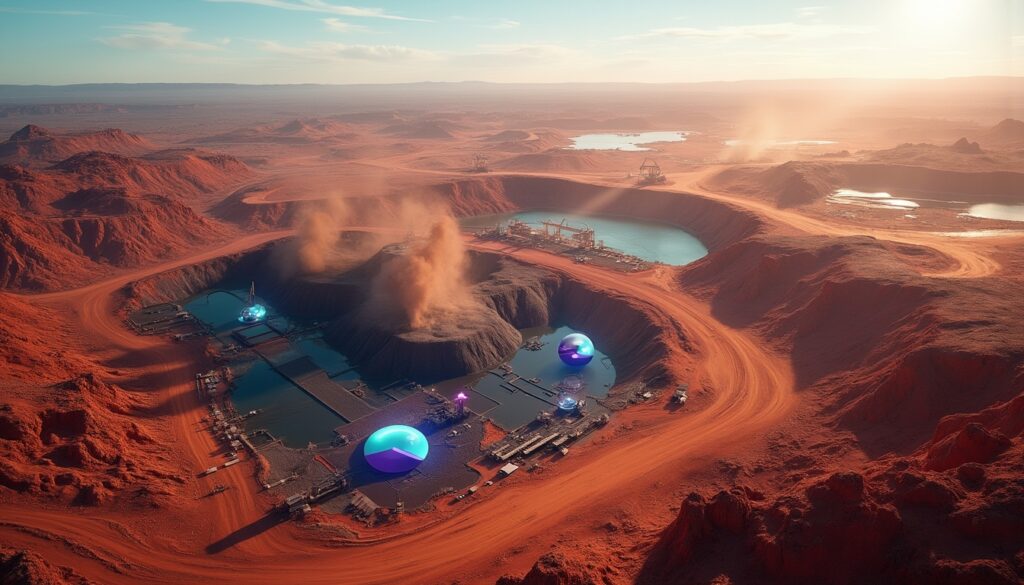What is the Butcherbird Manganese Mine Expansion Project?
The Element 25 Butcherbird expansion project approval has marked a significant turning point in Western Australia’s mining sector. This project is a strategic move by Element 25, aimed at strengthening its position in the global manganese market.
Following final regulatory approval in March 2025, the project is set to produce 1.1 million tonnes per annum (mtpa) of manganese concentrate. This milestone underscores the company’s commitment to sustainable resource development and echoes the importance of navigating the critical minerals race.
Element 25 Butcherbird expansion project approval is now a key term in discussions regarding Australia’s critical minerals strategy. The project supports both traditional steel markets and emerging battery materials sectors.
A recent update from the industry confirmed that Element 25’s final approval
recent regulatory news has paved the way for accelerated production plans.
Where is the Butcherbird Project Located and What Resources Does it Hold?
Located in the southern Pilbara region of Western Australia, the Butcherbird Project lies approximately 130km south of Newman. Its location offers clear logistical advantages with highways connecting to Port Hedland.
The project is Australia’s largest onshore manganese resource. Geological surveys estimate over 263 million tonnes of manganese ore across seven deposits:
- Yanneri Ridge
- Richies
- Mundawindi
- Coodamudgi
- Budjan
- Cadgies
- Pearana
Ore at Butcherbird is found near-surface at depths of 5-10 metres. This shallow profile reduces mining costs and improves economic viability. With an average manganese grade of 10–11%, the beneficiation process upgrades it to 30–35% concentrate for both steel and battery uses.
Experts note that the ore’s favourable metallurgical properties, such as low impurities, ensure further confidence in the asset's future.
What Regulatory Approvals Has Element 25 Secured?
Element 25 successfully navigated Australia’s multi-layered regulatory framework to secure all necessary approvals. In March 2025, the final statutory nod came from the WA Department of Water and Environmental Regulation.
Earlier in January 2025, the company cleared its mining proposal and mine closure plan with the WA Department of Energy, Mines, Industry Regulation and Safety. This approval demonstrated responsible resource extraction and progressive rehabilitation planning.
Additionally, the company secured critical access and Indigenous land use agreements. These agreements include heritage protection, environmental stewardship, and community benefit initiatives.
Element 25’s transparent approach has been praised for transforming the mining industry through ESG initiatives, ensuring that all stakeholders benefit from the project’s success.
What Are the Financial Projections for the Butcherbird Expansion?
The feasibility study, updated in January 2025, revealed impressive financial metrics that have captured investor interest. The expansion has an estimated capital cost of A$64.8 million (US$40.7 million), reflecting remarkable capital efficiency.
The pre-tax net present value stands at A$561 million. Significantly, the project boasts a pre-tax internal rate of return (IRR) of 96%, far surpassing typical mining project returns.
Element 25 projects average annual cash flows of A$70.5 million at full production. With a mine life exceeding 18 years, the project’s long-term sustainability is evident. Sensitivity analysis shows economic viability even under price pressure, with a breakeven manganese price estimated 30% below current levels.
These financial highlights demonstrate the sound reasoning behind the Element 25 Butcherbird expansion project approval and its future growth prospects.
How Does the Butcherbird Project Connect to Element 25’s International Operations?
The Butcherbird expansion is central to Element 25’s vertically integrated strategy spanning two continents. The expanded processing facility will supply manganese oxide concentrate to the steel industry while also supporting battery material applications.
A key facet of the plan is the feedstock for Element 25’s proposed HPMSM facility in Louisiana, USA. This facility will transform manganese concentrate into ultra-high-purity manganese sulphate monohydrate, essential for electric vehicle battery cathodes.
This integration addresses global battery supply chain challenges, strengthening supply security and reducing geopolitical risks. By linking Australian resources with American processing, Element 25 Butcherbird expansion project approval also secures a diversified supply chain for critical minerals.
Industry experts view this model as a forward-thinking approach within an increasingly competitive international marketplace.
What Strategic Partnerships Support Downstream Processing?
Element 25 has built strategic partnerships that underwrite its integrated manganese supply chain. Notably, collaborations with General Motors and Stellantis validate market demand while providing financial stability.
These partnerships include offtake agreements for battery-grade manganese products, ensuring reliable demand for Element 25’s outputs. In support of its downstream ambitions, the company also secured a US Department of Energy grant of US$166 million under the Bipartisan Infrastructure Law.
Element 25’s alliances extend to research partnerships with battery technology institutes. These partnerships improve HPMSM production and explore next-generation manganese-based chemistries. Furthermore, the collaboration strengthens mining’s crucial role in the clean energy transition, highlighting the company’s strategy and commitment to innovation.
Why is Manganese So Important in Modern Industries?
Manganese is uniquely positioned between traditional steel manufacturing and emerging battery technologies. Approximately 90% of manganese has been used in steel production, where it enhances hardness and wear resistance.
However, the role of manganese is rapidly evolving. In electric vehicle batteries, high-purity manganese is indispensable for cathode chemistries like NMC and LMFP. Its benefits include improved energy density, thermal stability, and cycle life while reducing reliance on more expensive metals.
Manganese’s dual-use significance has led to increased policy support in both Australia and the United States. Governments see manganese as integral for efforts to secure critical mineral supply chains during the energy transition.
What Timeline Can Be Expected for the Butcherbird Expansion Project?
With all approvals in hand, Element 25 is set for an accelerated rollout. Construction of the expanded processing facility is scheduled to begin immediately after approval in March 2025.
Key activities include:
- Construction of additional mining infrastructure.
- Expansion of water management systems.
- Development of tailings storage facilities.
- Upgrades to on-site power generation.
- Implementation of enhanced logistics capabilities.
Commissioning is expected 14 months after construction starts, with full production ramp-up reaching 1.1 mtpa over the next six months. Engineering innovations should improve manganese recovery by 15% relative to the initial facility, enhancing overall project performance and supporting the Element 25 Butcherbird expansion project approval.
FAQs About the Butcherbird Manganese Project
What makes the Butcherbird project significant in the Australian mining landscape?
Butcherbird is Australia’s largest onshore manganese resource and a critical part of the nation’s mineral portfolio. Its development under Element 25 Butcherbird expansion project approval positions it as a leading project for both steel markets and battery-grade material production.
How does manganese factor into the electric vehicle supply chain?
Manganese is vital for cathode chemistries in batteries such as NMC and LMFP. Enhanced purity levels improve battery performance, reduce costs, and are increasingly preferred by manufacturers. The evolving battery market accentuates mining’s crucial role in the clean energy transition.
What environmental considerations were addressed in the approval process?
Element 25’s rigorous environmental assessments covered water management, air quality, flora and fauna protection, and mine closure planning. Advanced techniques include:
- Dry processing methods reducing water usage by 40%.
- Integration of renewable energy sources supplying up to 15% of operations.
- Progressive reclamation and biodiversity offsets.
These measures exemplify advancements in mining industry decarbonisation.
How will the expanded production capacity impact local communities?
The expansion is set to create about 100 full-time operational jobs and 250 construction positions. Local community benefits include:
- Preferential hiring for regional and Indigenous applicants.
- A community development fund supporting education and cultural initiatives.
- Increased economic activity through local procurement.
What role does this project play in securing critical mineral supply chains?
By linking Australian manganese resources with American processing capabilities, the project diversifies supply sources amid global battery supply chain challenges. This integrated “mine-to-material” approach reinforces Element 25 Butcherbird expansion project approval as a vital development in securing a resilient and sustainable mineral supply chain.
Element 25 Butcherbird expansion project approval is more than just a regulatory milestone. It represents a strategic effort to fuse local resource development with global market demands, ensuring that both traditional and clean energy industries benefit from Australia’s abundant manganese reserves.
Looking to Capitalize on the Next Major Mineral Discovery?
Discovery Alert's proprietary Discovery IQ model instantly identifies significant ASX mineral discoveries like the Element 25 Butcherbird project, delivering real-time alerts that give you a crucial market advantage before the broader market reacts. Understand how major discoveries can lead to exceptional returns by exploring the dedicated discoveries page and position yourself ahead of the next mining opportunity.




